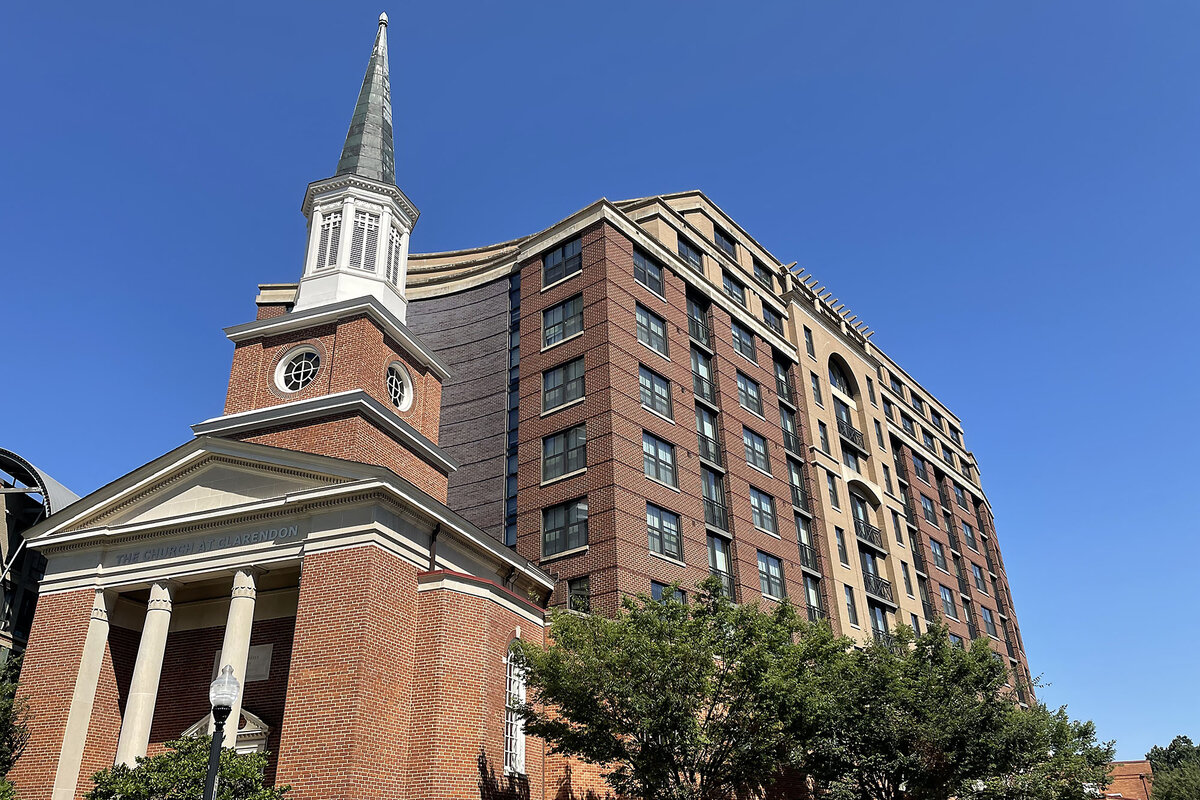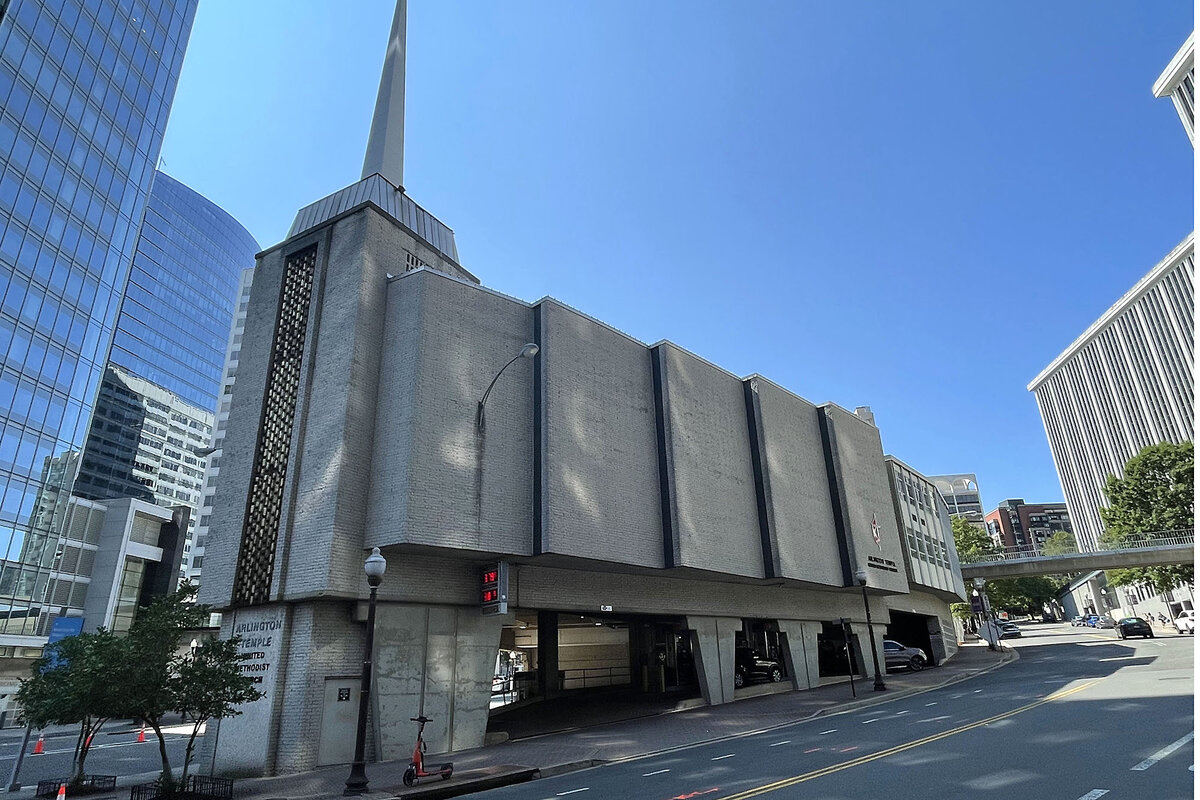How to save a church? Add housing, groceries, and gas.
Loading...
| Arlington, Va.
It began with the boiler, which stopped working in 2020. Related pumps, pipes, and hoses were also replaced at Clarendon Presbyterian Church, but there were still frequent leaks in the basement. The treasurer warned that the repair needed wasn’t financially feasible. The internet stopped working when it rained, leading to the discovery that the entire building needed to be rewired. Then one night in 2022, the windows in the third-floor preschool fell out of their frames and into the parking lot below.
Pastor Alice Tewell knew that her Arlington, Virginia, church was at a crossroads experienced by thousands of American churches forced to reevaluate the purpose and value of their properties.
More than 75 American churches of various denominations close their doors every week, estimated a 2019 report by the United Church of Christ’s Center for Analytics, Research & Development and Data. Shrinking memberships and oversize, aging buildings drive these closures.
Why We Wrote This
A story focused onShrinking church congregations are finding ways to preserve their physical place in the community by thinking innovatively about uses of their real estate. Part 1 of two.
Some congregations manage to stay in their churches by sharing their sanctuaries with other congregations, renting out unused space, or having only part-time clergy.
Others have found unusual solutions for financial stability. St. Bartholomew’s in New York City sold the air rights above the church for $78 million this year. The Arlington Temple United Methodist Church was an early model: Nicknamed “Our Lady of Exxon,” the church was originally built in 1970 with a rental space – a gas station – on the ground level below the steepled sanctuary. Most churches don’t have such valuable real estate assets, however, and many want their properties to continue to serve their communities in a way that matches their mission. In 2012, the Baptist Church at Clarendon here in Arlington built a 10-story building that included condominiums, 60% of which are for low-to-moderate-income residents. The church sanctuary occupies the bottom floors.
“In recent years, churches have found a number of ways to expand the use of their buildings and land for community benefit,” says Mark Elsdon, editor of the book “Gone for Good? Negotiating the Coming Wave of Church Property Transition.” He says solutions include “building affordable housing, creating new business incubators within their building, expanding food pantries into co-op groceries, opening church kitchens to food-based entrepreneurs, launching new early childhood education centers, and more.”
Church real estate offers myriad other uses
One example can be found in the Russell neighborhood of downtown Louisville, Kentucky. There, St. Peter’s United Church of Christ reached out to the UCC Church Building & Loan Fund for a $1 million loan to tackle the worst of the deferred maintenance on its 1895 church.
But even if the fund had given the church 10 times that amount, a refurbished church building wouldn’t have met the needs of its community, an impoverished African American neighborhood. Instead, the fund advised that the church work with an in-house program to determine the highest and best use of the property. After a few months of consultation, the program recommended that St. Peter’s work with the church-affiliated Molo Village Community Development Corp. to subdivide the property and use a vacant corner of the lot. The result was a 30,000-square-foot building for health care facilities, day care, a credit union, a coffee shop, and the first sit-down restaurant in that neighborhood in 50 years.
The St. Peter’s pastor was skeptical, but eventually agreed this was the best way to serve the community. It took eight years, but in 2021 The Village @ West Jefferson was completed, creating 100 jobs while continuing the church’s gospel-based mission to alleviate poverty.
Mr. Elsdon says dozens of churches have found creative, even radical, paths to a different future. And that number is expected to grow into the hundreds.
However, radical solutions require some radical thinking – something that doesn’t come naturally to congregants who’ve spent decades, or even lifetimes, following traditional ministry practices. Reaching agreement on a new mission and path forward can take years of soul-shaking consensus-building.
Professional help is an option endorsed by Laurel Wainwright, treasurer for Belmont-Watertown United Methodist Church in Massachusetts. Two congregations with church buildings a mile apart agreed to merge into one congregation several years ago and had to decide what to do with their properties.
“I can say – and this is speaking as the treasurer – the money we spent on outside consultants was money well spent,” says Ms. Wainwright. The consultants helped them build a framework to reach consensus, and led them in exploring public-private partnerships and developing requests for proposals. And, she adds, working with architects “helped us see the possibilities of what we could do along with the practical things we were going to have to take into account in our planning.”
Ms. Wainwright suggests congregations starting the process “take time to determine your end goal and make sure that’s clear to the whole congregation. Clarity is key.”
Now united in spirit and mission, Belmont-Watertown is still looking for the right solution for their aging properties that will allow them to continue serving their community.
Turning loss of beloved edifice into gain
Bob Stains, the consultant who helped Belmont-Watertown through the initial stages, stresses the importance of building listening skills in any kind of transformation.
“We ask our participants to share the experiences they’ve had at their church that illustrate why they treasure the church and stay involved with it,” explains Mr. Stains. “We also acknowledge the loss that comes with transformation and that many people may need to grieve that loss before they are ready to move forward. And then we ask what they need to welcome, find space for, or create, to move forward as a unified church.”
Once agreement on mission and purpose has been reached, successfully reinventing a church’s place in the community involves knowing the needs of that community and what services or facilities would be of greatest value to the people living there.
Clarendon Presbyterian in Virginia has just finished that part. It took the congregation two years to decide to replace the traditional church edifice with affordable housing and space for programming designed to support older people in the LGBTQ+ community. Before any construction begins, Clarendon Presbyterian still has much decision-making ahead on making practical considerations, abiding by building codes, and maintaining good relations with nearby property owners.
“We were fortunate to have so little conflict within our congregation, but the rest of the process will be a bit more challenging,” says Ms. Tewell, the Presbyterian pastor. “We’ll take our courage from God, though, because our redevelopment is an act of our faith.”
There are many paths available to congregations whose property no longer works for them, and each solution will be a little different. But churches already on the way suggest that congregations are most successful when they take time to really listen to one another and their neighbors about what’s best for the whole community.







